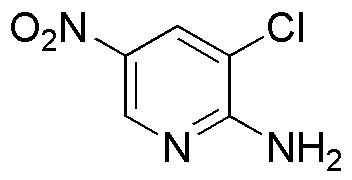2-Amino-3-chloro-5-nitropyridine is widely utilized in research focused on:
- Pharmaceutical Development: This compound serves as a key intermediate in the synthesis of various pharmaceuticals, particularly in the development of anti-infective agents and anti-cancer drugs.
- Agricultural Chemistry: It is used in the formulation of agrochemicals, including herbicides and pesticides, enhancing crop protection and yield.
- Material Science: The compound is explored for its potential in creating specialized polymers and coatings, which can improve durability and resistance to environmental factors.
- Analytical Chemistry: It acts as a reagent in analytical methods, aiding in the detection and quantification of other compounds in complex mixtures.
- Research in Organic Synthesis: This chemical is valuable in organic synthesis as a building block for creating more complex molecules, facilitating advancements in various chemical research fields.
General Information
Properties
Safety and Regulations
Applications
2-Amino-3-chloro-5-nitropyridine is widely utilized in research focused on:
- Pharmaceutical Development: This compound serves as a key intermediate in the synthesis of various pharmaceuticals, particularly in the development of anti-infective agents and anti-cancer drugs.
- Agricultural Chemistry: It is used in the formulation of agrochemicals, including herbicides and pesticides, enhancing crop protection and yield.
- Material Science: The compound is explored for its potential in creating specialized polymers and coatings, which can improve durability and resistance to environmental factors.
- Analytical Chemistry: It acts as a reagent in analytical methods, aiding in the detection and quantification of other compounds in complex mixtures.
- Research in Organic Synthesis: This chemical is valuable in organic synthesis as a building block for creating more complex molecules, facilitating advancements in various chemical research fields.
Documents
Safety Data Sheets (SDS)
The SDS provides comprehensive safety information on handling, storage, and disposal of the product.
Product Specification (PS)
The PS provides a comprehensive breakdown of the product’s properties, including chemical composition, physical state, purity, and storage requirements. It also details acceptable quality ranges and the product's intended applications.
Certificates of Analysis (COA)
Search for Certificates of Analysis (COA) by entering the products Lot Number. Lot and Batch Numbers can be found on a product’s label following the words ‘Lot’ or ‘Batch’.
*Catalog Number
*Lot Number
Certificates Of Origin (COO)
This COO confirms the country where the product was manufactured, and also details the materials and components used in it and whether it is derived from natural, synthetic, or other specific sources. This certificate may be required for customs, trade, and regulatory compliance.
*Catalog Number
*Lot Number
Safety Data Sheets (SDS)
The SDS provides comprehensive safety information on handling, storage, and disposal of the product.
DownloadProduct Specification (PS)
The PS provides a comprehensive breakdown of the product’s properties, including chemical composition, physical state, purity, and storage requirements. It also details acceptable quality ranges and the product's intended applications.
DownloadCertificates of Analysis (COA)
Search for Certificates of Analysis (COA) by entering the products Lot Number. Lot and Batch Numbers can be found on a product’s label following the words ‘Lot’ or ‘Batch’.
*Catalog Number
*Lot Number
Certificates Of Origin (COO)
This COO confirms the country where the product was manufactured, and also details the materials and components used in it and whether it is derived from natural, synthetic, or other specific sources. This certificate may be required for customs, trade, and regulatory compliance.


